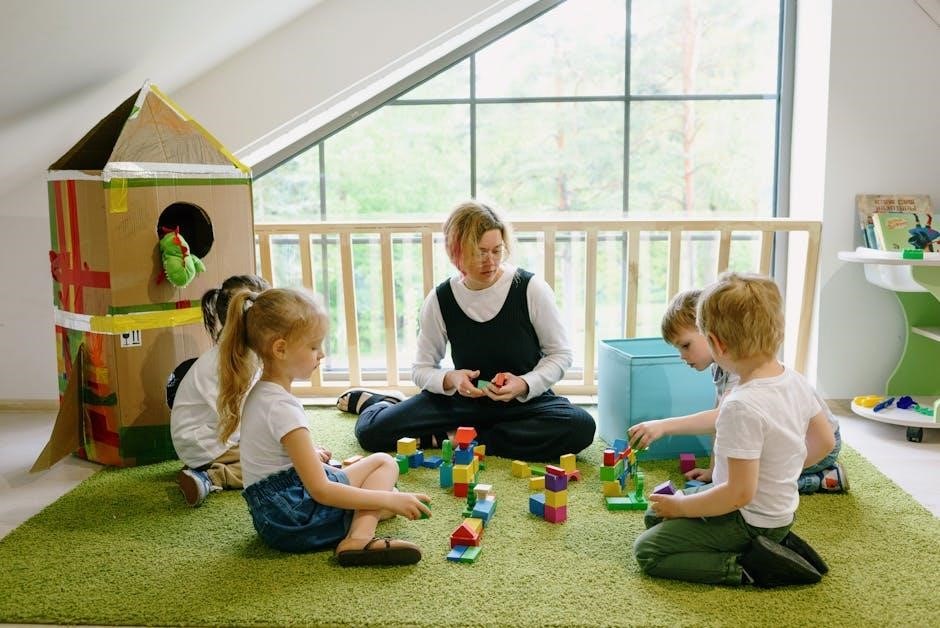Primary teacher interviews often involve a mix of behavioral, situational, and subject-specific questions. Preparing for these questions is crucial to showcase your teaching philosophy, classroom management strategies, and adaptability. Downloading a PDF guide with common questions and model answers can help you practice and refine your responses effectively. This section provides an overview of the types of questions you may encounter, helping you feel confident and prepared for your interview.
1.1 Importance of Preparation for Primary Teacher Interviews
Preparation is crucial for primary teacher interviews. Researching the school, practicing common questions, and preparing thoughtful inquiries demonstrates initiative and confidence. Understanding the curriculum, classroom management, and teaching philosophies helps tailor responses. Showcase enthusiasm for teaching and student development. Effective preparation highlights professionalism and readiness to contribute to the school community, increasing your chances of a successful interview.
1.2 Overview of Common Interview Topics for Primary Teachers
Primary teacher interviews cover various topics, including teaching philosophy, classroom management, and subject-specific methods. Candidates are often asked about their motivation, adaptability, and strategies for engaging students. Past experiences and lessons learned are also common, along with questions on technology integration and handling challenging behaviors. Understanding these areas ensures comprehensive preparation and confident responses during the interview process.

Common Primary Teacher Interview Questions
Interviews often focus on motivation, teaching style, classroom management, and subject expertise. Questions also address adaptability, handling challenging behaviors, and strategies for engaging young learners effectively.
2.1 Why Do You Want to Become a Primary Teacher?
Interviewers ask this to understand your motivation and passion for teaching. They look for evidence of your commitment to shaping young minds and fostering a love for learning. Your answer should reflect your desire to make a difference in the early stages of a child’s educational journey and highlight your dedication to the profession.
2.2 What Makes You a Good Fit for This School?
Your answer should align with the school’s mission and values, showcasing your unique skills and experiences. Highlight how your teaching style and philosophy match the school’s approach. Emphasize your enthusiasm for the school’s culture and how you can contribute to its community. Demonstrate understanding of the school’s specific needs and how you can support its goals effectively.
2.3 What Do You Know About Our School?
Researching the school’s mission, values, and culture is essential. Highlight specific programs, achievements, or initiatives that resonate with your teaching philosophy. Mention how the school’s approach to education aligns with your own beliefs and practices. Demonstrating knowledge shows your genuine interest and preparation, helping you stand out as a thoughtful and engaged candidate.
Teaching Philosophy and Style
Your teaching philosophy guides your instructional principles and practices. A student-centered approach fosters creativity and critical thinking, while a structured style ensures clarity and engagement, creating an inclusive learning environment.
3.1 What Is Your Teaching Philosophy?
Your teaching philosophy reflects your core beliefs about education and student learning. Emphasize creating a supportive, inclusive environment that encourages curiosity, creativity, and growth. Highlight your commitment to fostering social-emotional development alongside academic achievement, ensuring each student feels valued and empowered to succeed.
3.2 How Would You Describe Your Teaching Style?
Describe your teaching style as adaptable and engaging, focused on student-centered learning. Utilize hands-on activities, collaborative projects, and differentiated instruction to cater to diverse needs. Integrate technology to enhance lessons and make them interactive. Maintain high expectations while fostering a supportive, inclusive environment that encourages creativity and critical thinking. This approach ensures all students are motivated and empowered to succeed.
Classroom Management and Strategies
Effective classroom management involves creating a structured, respectful environment with clear expectations and positive reinforcement. Strategies include establishing routines, encouraging student responsibility, and addressing behaviors proactively to ensure a productive learning atmosphere.
4.1 Describe Your Classroom Management Style
My classroom management style is centered around consistency, positivity, and mutual respect. I establish clear expectations and routines, using positive reinforcement to encourage good behavior. I also incorporate student involvement in setting rules, fostering a sense of ownership and accountability. This approach creates a supportive, structured environment where students feel safe and motivated to learn effectively.
4.2 How Do You Handle Challenging Behavior in the Classroom?
I address challenging behavior by remaining calm and empathetic, identifying triggers, and using restorative practices. I focus on understanding the student’s perspective, reinforcing positive alternatives, and providing individual support. Consistent consequences and collaborative problem-solving with students help maintain a respectful and focused learning environment, ensuring all students feel supported and valued in their growth.

Subject-Specific Questions
This section covers strategies for teaching core subjects effectively and making lessons engaging for young students, ensuring they grasp key concepts in a fun and interactive way.
5.1 How Do You Teach Core Subjects Like Math and English?
Teaching core subjects involves making lessons engaging and interactive. For math, use real-life examples and hands-on activities to simplify concepts. For English, incorporate reading aloud, group discussions, and creative writing to foster language skills. Adapt teaching methods to meet students’ needs, ensuring a strong foundation in both subjects while keeping lessons enjoyable and effective for young learners.
5.2 How Do You Make Lessons Engaging for Young Students?
Engaging young students involves interactive activities, hands-on learning, and incorporating technology. Use visual aids, storytelling, and group collaboration to make lessons relatable and fun. Encourage creativity through art, music, and role-playing, while connecting topics to their daily lives. This approach fosters curiosity, keeps students focused, and helps build a strong foundation for lifelong learning while maintaining their interest and enthusiasm.

Past Experiences and Lessons Learned
Reflecting on past teaching experiences helps identify successful strategies and areas for growth. Sharing specific examples demonstrates how you’ve evolved as an educator and problem-solver.
6.1 Tell Us About a Time You Helped a Struggling Student
A time I helped a struggling student was by identifying their learning gaps and creating a tailored support plan. I incorporated visual aids and one-on-one sessions, collaborating with colleagues to ensure progress. The student’s confidence and grades improved significantly, demonstrating the impact of personalized attention and adaptive teaching strategies.
6.2 What Have You Learned from Your Teaching Experiences?
Through teaching, I’ve learned the importance of adaptability, patience, and personalized learning. Every student learns differently, so tailoring strategies to meet individual needs is crucial. I’ve also realized the value of building strong relationships and using feedback to refine my methods. These experiences have shaped my approach to creating engaging and inclusive learning environments.
Adaptability and Curriculum
Adaptability is key in teaching, as curriculum changes and diverse student needs require flexibility. Continuous learning and professional development help educators stay updated and effective in their roles.
7.1 How Do You Adapt to Changes in the Curriculum?
Adapting to curriculum changes requires a proactive approach, staying informed about updates, and engaging in professional development. Collaboration with colleagues and flexibility in lesson planning ensure seamless integration of new content, maintaining student engagement and meeting educational goals effectively.
7.2 How Do You Teach Something That Is Not Your Strength?
When teaching a subject outside your expertise, thorough preparation and leveraging available resources are key. Engaging students through interactive methods and seeking support from colleagues or professional materials ensures effective delivery. Recognizing areas for growth and maintaining a positive, adaptable attitude fosters a productive learning environment for all students.
Professional Development and Growth
Staying updated with teaching methods, attending workshops, and applying knowledge ensures continuous improvement, benefiting both educators and students in the classroom environment effectively.
8.1 How Do You Stay Updated with Teaching Methods?
To stay updated, I participate in workshops, attend professional development courses, and subscribe to educational journals. I also engage in online forums and follow expert blogs to learn about innovative teaching strategies and tools, ensuring I can adapt and improve my instructional techniques for the benefit of my students and classroom environment.
8.2 What Workshops or Courses Have You Attended Recently?
I recently attended workshops on technology integration in the classroom and strategies for managing diverse learning needs. I also completed a course on innovative teaching methods for primary students. These experiences have enhanced my ability to adapt to modern educational standards and implement effective teaching practices that cater to all learners.

Technology in the Classroom
Technology enhances learning by making it interactive and engaging. I use digital tools like educational apps and online resources to create dynamic lessons and assess student progress effectively.
9.1 How Do You Use Technology to Enhance Learning?
Technology is integrated into my teaching to create engaging, interactive lessons. I use educational apps, multimedia resources, and online platforms to make learning fun and accessible. Digital tools help students visualize concepts, collaborate on projects, and access real-time feedback. This approach fosters a dynamic classroom environment, catering to diverse learning styles and promoting deeper understanding of the curriculum.
9.2 What Digital Tools Do You Find Most Effective?
I find tools like Kahoot, Google Classroom, and educational apps highly effective for engaging students. These platforms facilitate interactive learning, real-time feedback, and personalized instruction. They also enable seamless communication and collaboration, making lessons more dynamic and accessible. By leveraging these tools, I create a modern, inclusive learning environment that caters to diverse student needs and enhances overall academic outcomes.
Challenges in Teaching
Common challenges include managing diverse learning needs, maintaining student engagement, and adapting to curriculum changes. Effective strategies like differentiated instruction and technology integration help address these issues.
10.1 What Do You Find Most Challenging in Teaching?
One of the most significant challenges in teaching is catering to diverse learning needs. Every student has unique abilities and pace, making it essential to adapt teaching methods. Additionally, managing classroom behavior and ensuring all students remain engaged can be difficult. Staying updated with curriculum changes and integrating technology effectively are also common challenges faced by educators today.
10.2 How Do You Support Students with Diverse Needs?
To support students with diverse needs, I use differentiated instruction, incorporating various learning strategies and resources. I also collaborate with specialists and utilize assistive technologies to ensure inclusivity. By understanding each student’s strengths and challenges, I tailor my teaching to meet individual requirements, fostering a supportive and inclusive learning environment that encourages every child to thrive.
Role of Parents and Community
Engaging parents and the community is vital for student success. Regular communication through meetings, reports, and digital tools ensures transparency. Collaborating with parents and involving the community in educational activities fosters a supportive learning environment and strengthens student outcomes.
11.1 How Do You Communicate with Parents?
Effective communication with parents is key to student success. I use regular parent-teacher meetings, progress reports, and emails to keep them informed. I also leverage digital tools like classroom apps for real-time updates. Open dialogue and active listening ensure parents feel involved. Additionally, I encourage parents to participate in educational activities, fostering a collaborative environment for their child’s growth and development.
11.2 How Do You Involve Parents in Their Child’s Education?
Involving parents in their child’s education fosters a supportive learning environment. I encourage parents to volunteer in class, attend parent-teacher meetings, and participate in school events. Regular updates through emails, newsletters, and digital platforms keep them informed. Additionally, I suggest ways parents can reinforce learning at home, creating a collaborative partnership that benefits the child’s academic and personal growth.
Preparation is key to acing your primary teacher interview. Downloading a PDF guide with questions and answers ensures you’re well-equipped to impress. Use this resource wisely to succeed.
12.1 Final Tips for Acing a Primary Teacher Interview
Be confident and genuine, showcasing your passion for teaching. Research the school and practice common questions. Highlight your teaching philosophy and classroom management style. Use specific examples from your experiences. Demonstrate adaptability and willingness to learn. Dress professionally and arrive early. Stay positive and engaged throughout the interview. Downloading a PDF guide with questions and answers can also help you prepare effectively for your interview.
12.2 How to Download Primary Teacher Interview Questions and Answers PDF
To access primary teacher interview questions and answers, visit reputable educational websites or platforms offering teaching resources. Look for downloadable PDF guides that include top questions, sample answers, and tips. Many sites provide free or paid resources. Simply click the download button, save the file, and review the content to prepare effectively for your interview. This resource will help you practice and confidence.
